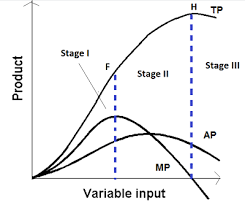Law of diminishing return -N
>straight line vs curved line
>specialisation in business/trade
>division of labour
 Produtcs= output
Produtcs= output
variable output= no. of workers
Points when drawing:
draw AP then MP then TP
MP goes through the tip of AP
When MP goes through the x axis that’s when TP peaks
Total Productions:
An increase in workers = increase in output
Begins to slow down and then when MP=0 TP peaks and it begins to dip due to the law of diminishing returns (overmanning)
Average Product:
increases steadily until MP runs through its peak then it dips
this is because as the output decreases the no. of workers still increases causing the average to decrease after the MP = AP
Marginal Product:
Law of diminishing returns explains the shape of the curve
Curved PPF curve - it is curved because not all the skills and FOP are interchangeable so they would need training to become as efficient as they were - law of increasing opportunity cost
Straight PPF curve - it is straight because all the of skills and FOP are interchangeable , law of constant returns- law of constant opportunity cost
Specialisation for a business
when that business concentrates on one particular good or service
Specialisation in trade
Countries with comparative advantage will specialise in specific goods/services in order to gain the most revenue
Japan specialises in producing high-tech electronic goods
Cuba specialises in sugar
Division of labour
workers are placed into specific areas in order to increase productivity and increase specialisation in the workers
Benefits | Problems | |
|---|---|---|
Specialisation for labour | ^ productivity lower costs division of labour can decrease time trained economics of scale | repetitive/boring possible diseconomies of scale if absent, harder to fill vacancy higher cost as specialised workers are in higher demand |
Specialisation in trade | leads to ^ living standards greater choice of goods more choice countries don’t have to produce every good they need(comparative advantage) enables countries to import in goods they need | over dependance on specialised products (Saudi Arabia and oil) may hamper development if countries stick to primary products which have low-income elasticity of demand
|